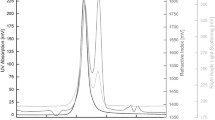Abstract
Catalase activity in crude extracts ofEscherichia coli has two pH optima: one at pH 6.8 and the other at pH 10.5. The former is inducible by H2O2 and is the major species in exponential cells. The latter is constitutive and is the major species in stationary cells. Both activities are repressed by glucose. Catalase-negative mutants that are impaired in the pH-6.8 activity were isolated by the inability of aerobically grown mutagenized colonies to decompose H2O2. One mutant (cat2) characterized is hypersensitive to H2O2.
Similar content being viewed by others
Literature Cited
Adelberg, E. A., Mandel, M., Chen, G. C. C. 1965. Optimal conditions for mutagenesis byN-methyl-N′-nitronitrosoguanidine inEscherichia coli Biochemical and Biophysical Research Communications18:788–795.
Ananthaswamy, H. N., Eisenstark, A. 1977. Repair of hydrogen-peroxide induced single strand breaks inEscherichia coli deoxyribonucleic acid. Journal of Bacteriology130:187–191.
Asada, K., Takahashi, M., Nagate, M. 1974. Assay and inhibitors of spinach superoxide dismutase. Agricultural and Biological Chemistry38:471–473.
Barbado, C., Ramirez, M., Angel-Blanco, M., Lopez-Barea, J., Pueyo, C. 1983. Mutants ofEscherichia coli sensitive to hydrogen peroxide. Current Microbiology8:251–253.
Beers, Jr., R. F., Sizer, I. W. 1952. A spectrophotometric method for measuring the breakdown of hydrogen peroxide by catalase. Journal of Biological Chemistry195:133–140.
Chance, B. 1952. Effect of pH upon the reaction kinetics of the enzyme substrate compounds of catalase. Journal of Biological Chemistry194:471–481.
Chance, B., Sies, H., Boveris, A. 1979. Hydroperoxide metabolism in mammalian organs. Physiological Reviews59:527–605.
Claireborne, A., Fridovich, I. 1979. Purification of theO-dianisidine peroxidase fromEscherichia coli B. Journal of Biological Chemistry254:4245–4252.
Claireborne, A., Malinowski, D. P., Fridovich, I. 1979. Purification and characterization of hydroperoxidase II ofEscherichia coli. Journal of Biological Chemistry254:11664–11668.
Demple, B., Halbrook, J., Linn, S. 1983.Escherichia coli xth mutants are hypersensitive to hydrogen peroxide. Journal of Bacteriology153:1079–1082.
Guidotti, G., Colombo, J., Foa, P. O. 1961. Enzymatic determinations of glucose: stabilization of color developed by dianisidine. Analytical Chemistry33:151–153.
Hassan, H. M., Fridovich, I. 1977. Physiological function of superoxide dismutase in glucose-limited chemostat cultures ofEscherichia coli. Journal of Bacteriology130:805–811.
Hassan, H. M., Fridovich, I. 1978. Regulation of the synthesis of catalase and peroxidase inEscherichia coli. Journal of Biological Chemistry253:6445–6450.
Hassan, H. M., Fridovich, I. 1979. Superoxide, hydrogen peroxide and oxygen tolerance of oxygen-sensitive mutants ofEscherichia coli. Reviews of Infectious Diseases1:357–366.
Levine, S. A. 1977. Isolation and characterization of catalase deficient mutants ofSalmonella typhimurium. Molecular and General Genetics150:205–209.
Lowry, O. H., Rosenbrough, N. J., Farr, A. L., Randall, R. J. 1951. Protein measurements with the Folin phenol reagent. Journal of Biological Chemistry193:265–275.
McCord, J. M., Fridovich, I. (1969). Superoxide dismutase. Journal of Biological Chemistry244:6049–6055.
Miller J. H. 1972. Experiments in molecular genetics. Cold Spring Harbor: Cold Spring Harbor Laboratory.
Morgan, A. R., Cove, R. L., Elgert, T. M. 1976. The mechanism of DNA strand breakage by vitamin C and superoxide and the protective role of catalase and superoxide dismutase. Nucleic Acid Research3:1139–1149.
Pachecka, J., Litwinska, J., Bilinski, T. 1974. Hemoproteid formation in yeast. I. Isolation of catalase and cytochrome.-deficient mutants. Molecular and General Genetics134:299–305.
Reich, I., Sayar, D., Hochman, A. 1984. Is catalase an enzyme without a pH optimum? Israel Journal of Medical Sciences in press.
Richter, H. E., Loewen, P. C. 1981. Induction of catalase inEscherichia coli by ascorbic acid involves hydrogen peroxide. Biochemical and Biophysical Research Communication100:1039–1046.
Richter, H. E., Loewen P. C. 1982. Catalase synthesis inEscherichia coli is not controlled by catabolite repression. Archives of Biochemistry and Biophysics215:72–77.
Seah, T. C. M., Kaplan, J. G. 1973. Purification and properties of the catalase of baker's yeast. Journal of Biological Chemistry248:2889–2893.
Yoshpe-Purer, Y., Henis, Y. 1976. Factors affecting catalase level and sensitivity to hydrogen peroxide inEscherichia coli. Applied and Environmental Microbiology. Journal of Bacteriology32:465–469.
Yoshpe-Purer, Y., Henis, Y., Yashphe, J. 1977. Regulation of catalase level inEscherichia coli K12. Canadian Journal of Microbiology23:84–91.
Author information
Authors and Affiliations
Rights and permissions
About this article
Cite this article
Meir, E., Yagil, E. Catalase-negative mutants ofEscherichia coli . Current Microbiology 11, 13–17 (1984). https://doi.org/10.1007/BF01567569
Issue Date:
DOI: https://doi.org/10.1007/BF01567569




